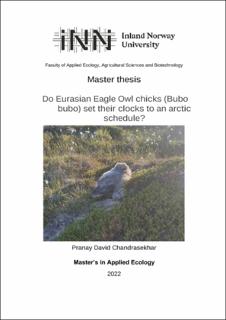| dc.description.abstract | Organisms survive the earth’s challenging environments by capitalising on predictable changes in biotic and abiotic conditions, thereby establishing circadian rhythms. These rhythms can be synchronised to different cues (or zeitgebers), the most common one being light. The interaction between light and circadian activity varies greatly between species and populations, even within the same habitat. Light is expected to be an important cue for nocturnal species; however, for nocturnal species inhabiting high-latitude areas, extended daylight during summer may pose a challenge. In the Sleneset archipelago of Northern Norway, close to the Arctic circle, there is a population of Eurasian eagle owls (bubo bubo), a typically nocturnal predator, which is exposed to continuous midsummer daylight. While adults have been found to maintain their nocturnality under these conditions, it is unclear whether the same can be said for nestlings and fledglings. In June-July 2018 and 2019, SM4 recorders were placed at five nest sites in Sleneset and three nest sites in Southern Norway which experience dark nights during summer. A machine learning software was used to develop, refine and assess a vocal classification algorithm, to extract Eagle owl chick begging calls from the acoustic data. Hourly calling patterns were compared between locations to assess the effect of continuous daylight. Eagle owl chicks exposed to continuous daylight were found to have a nocturnal peak in vocal activity and to call during the daytime as well. It is suggested that these activity patterns reflect entrainment to parental activity and possibly the risk of intra-guild predation by sea-eagles. Daytime calling is also in line with literature on sibling communication and vocal practice. Chicks near the Arctic circle also called more frequently than those in Southern areas with dark nights. This was related to a potential positive-feedback loop wherein prey abundance might induce more frequent begging. The vocal classification method was able to detect chick begging calls with an average of 69% accuracy, highlighting its potential as a non-invasive method for analysing activity patterns, while leaving some room for improvement. | en_US |
